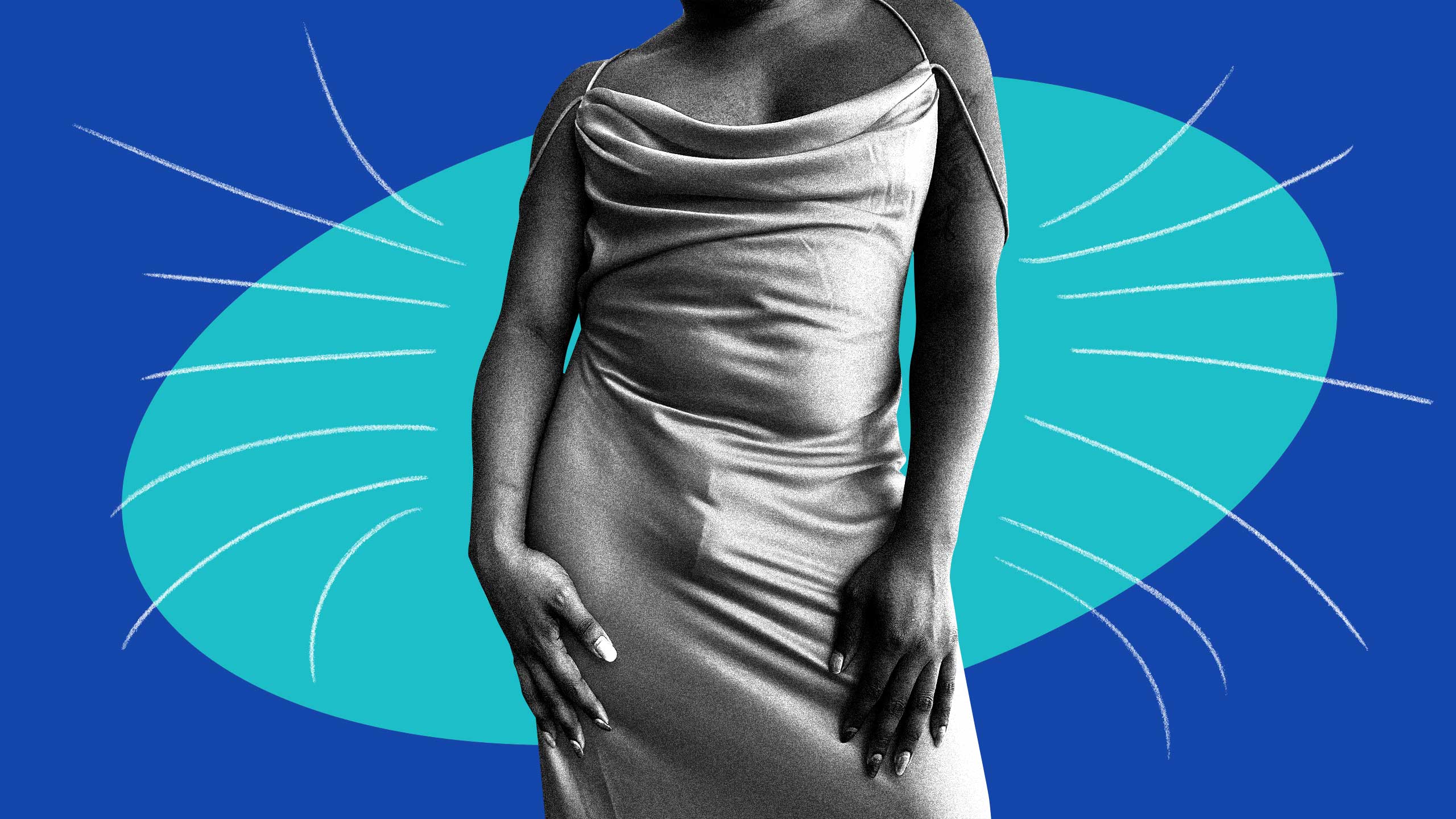I have never had a dainty tuck. Though I’ve tried navigating the physical limitations of that which I’ve been blessed with and the associated sometimes-pain of folding and flattening myself for others’ approval, my tuck is a meaty girl.
I was confronted with this fact a few weeks ago during my 30th birthday party. In true Leo fashion, I invited friends, colleagues and peers to my apartment rooftop to (safely, because of the pandemic) celebrate my brilliance over fried chicken, oxtails and libations. And as any Leo or friend of a Leo knows, it is of utmost importance that I was the centre of attention. I figured my outfit could factor into that greatly, settling on a brown and tan, sheer, artsy-camo beach coverup I saw in an acquaintance’s IG stories earlier in the summer. I paired it with a Urbody gender-affirming thong yanked to the high heavens—my tucking tool of choice—and a sensible wedge heel. When I emerged from the elevator to my waiting guests, their raised eyebrows, incessant snaps and boisterous repetitions of “Okay, bitch!” let me know I’d accomplished my mission of gaggery.
An hour or so later, a close friend pulled me aside. Like a church mother trying to covertly tell an usher that her slip is showing, he tells me that my tuck had undergone a metamorphosis. What was originally a rather flat situation had become, after a few drinks and some carrying on, a petite bulge.
“Everybody here knows I got a penis!” I, quite instinctually and tipsily, exclaimed for all of Hollywood to hear. At the moment, it was the only response I could think of, at once a statement of fact and a notice for everyone else who was likely thinking the same thing.
“What’s so wrong about a meaty tuck?”
But in the weeks since, I haven’t been able to rid myself of that memory. While thinking a lot about the expectations we place on our bodies, and others’, to conform to supposed standards of beauty, front of mind has been the conscious and unconscious motivations we have, especially as non-binary and trans people, for the things we do to our vessels to survive and ensure safety—and to slay!
“What’s so wrong about a meaty tuck?” I keep asking myself. “Why do I feel compelled to tuck, albeit haphazardly, in the first place?” Here’s my journey to finding some answers.
Tucking, for the unaware, is the process by which some people who have penises and/or testicles hide those body parts. While there are many ways to do so (stay out of trans people’s business!), the ultimate goal is to ensure a bulge cannot be seen through one’s clothing. The practice of tucking is perhaps most often ascribed to drag queens and trans women, though the purposes behind each can be drastically different.
For drag queens, especially cis guys, tucking is a means of helping them accomplish the illusion they’re aiming for. Because drag is often defined as men donning wigs and makeup to create a (sometimes hyper) realistic portrayal of women, the goal is often to remove as many indications as possible that a queen is not a “real” woman. This includes but is not limited to removing one’s facial and body hair, wearing padding to effect a “womanly” shape and, of course, tucking to remove crotch bulges. Obviously this perpetuates binaristic and essentialist understandings of gender and whatnot—though there are some queens whose style of drag challenges such conceptions, too—but that’s a topic for a different article!
As for trans people, tucking can be a deeply personal tool to help alleviate dysphoria. The temporary removal or binding of (ir)relevant body parts can have immense emotional and psychological benefits for an individual, helping them be able to go about their days the best they can. The practice can also ensure safety and security when navigating life as a trans person in a transphobic society is already precarious. Having a visible bulge, then, for a trans woman or femme can heighten that experience and expose us to various violences. (Femme, by the way, can be defined in as many ways as there are femme people. I apply the term to someone—usually assigned male at birth but not always—who embodies that which society considers feminine in their gender identity, presentation or expression, but may not necessarily identify as a woman.)
But when tucking is removed from its mostly private benefits for trans people and becomes a point of comment or judgement from non-trans folk, something insidious happens. As Lore/tta LeMaster, an assistant professor at Arizona State University whose work in communication studies focuses on queer and trans people of colour, says, “We move into a moralistic standard that’s about intelligibility.” And intelligibility—whether or not our bodies and gender identities, presentations and expressions are easily understood or palatable to others—is never about trans or femme euphoria; it’s about cis approval.
Moreover, conversations about the bodies and presentations of folks from historically excluded communities is necessarily connected to a long history of white supremacist obsessions with the bodies of communities of colour, especially Black people. This means that, in LeMaster’s words, intelligibility is ultimately “always and only about whiteness [and] really a conversation with white folk talking to white folk about how to do gender.” Not recognizing this, she says, “allows us to simply talk about the ‘meaty tuck’ and not talk about the racist undertones that are implied about what is a ‘proper’ genital?”
“Folks of all gender experiences ogle the bodies of trans people, reproducing the very policing that has historically subjugated, in particular, Black women and femmes.”
In 19th-century Europe, for example, at least two South African women were treated as freak show attractions under the monikers Sarah Baartman and Hottentot Venus. They were exhibited and gawked at for white consumption because the size of their butts were larger than Europeans’ and therefore not proper and somehow subhuman. Such context is important to understand, LeMaster contends, because in the ways Europeans ogled the body of Baartman as an aberration, so too do folks of all gender experiences ogle the bodies of trans people, reproducing the very policing that has historically subjugated, in particular, Black women and femmes.
I’m also reminded of “masquerade laws” that, by the turn of the 20th century, were being used to target what William Eskridge Jr., author of Gaylaw: Challenging the Apartheid of the Closet, termed as “gender inappropriateness.” The infamous “three-article rule,” which required queer and trans people to wear at least three articles of clothing associated with the sex they were assigned at birth in order to avoid being arrested for cross-dressing, is an outgrowth of these laws, all of which are about white, cisgender, often heterosexual people’s preoccupation with our bodies.
Having a meaty tuck, then, upends one’s intelligibility. It unsettles the often binaristic understandings of gender identity and presentation. Because in a binary world, only men have crotch bulges while women, which is what they believe femmes are trying to be, don’t. Therefore, a femme-presenting person with a visible crotch bulge challenges conceptions of womanhood, femininity and respectability that dictate how we’re supposed to show up in public, whether it’s at the gym, work, the grocery store or even our own birthday parties.
But being a femme person is not the same as being a woman, and some women have penises. Therefore, it’s necessary to see “womanhood” as the “bourgeois, white expression of respectability” it is, LeMaster asserts, and recognize that so many people—and not just trans and non-binary folk—will never embody it.
“[They say] we look a wreck, because we’re not that,” continues LeMaster, who is a non-binary trans/sexual femme and uses she and they pronouns interchangeably. “But when we move towards unintelligibility, it means we recognize this staple and we queer it.” Referencing the work of Cuban American academic José Esteban Muñoz, they say “the meaty tuck in some ways is dis-identifying with white notions of womanhood [because it’s] not about womanhood. It’s about femme expression.”
To be femme, then, is to be seen as ugly, to not be respectable—which is not a bad thing! To be femme is to not be concerned with fitting in or living up to various standards that can’t hold our full brilliance anyway. “Ugly is in fact the thing we should be striving towards,” LeMaster notes.
Because it is, in and of itself, a rebuke of the systems that have told us that a meaty tuck is a problem in the first place.
I don’t remember learning that I needed to be bulge-less when out in the world. Perhaps all those years of watching RuPaul’s Drag Race before I came into my non-binary bad bitchery subconciously ingrained such an idea in my mind. That, and the fact that the trans people who were and are afforded visibility most often don’t necessarily move through the world like I do. Then there are the very real concerns about the violences that may come if I let it all hang out in my favourite bodycon dress, about what men might do when their attraction to what they see unsettles their understanding of who they are.
“I think the situation is a great example of the ways we might be unconsciously perpetuating various ideas about respectability.”
In retrospect, I guess just about everything and everyone has, in ways large and small, told non-binary and trans people that we must tuck—not for personal euphoria or our mental and emotional well-being, but to disturb as little as possible around us. “You can be trans all you want,” the thinking seems to go, “but you’re either a man or a woman. There’s no room for the in-between.”
I know for a fact that my friend meant no harm in alerting me to the undoing of my haphazard tuck. Still, I think the situation is a great example of the ways we might be unconsciously perpetuating various ideas about respectability. Admittedly, I love the look that comes with a tight tuck. “Women’s clothes” are often unforgiving for those of us with a special something something below our waists. Considering a flat tuck helps everything lay better, or as intended, on the body.
But perhaps I only believe this because some of my conceptions of beauty are anti-trans and anti-Black. Perhaps you feel the need to gawk or look away because your conceptions of beauty are anti-trans and anti-Black, too.
I’m exhausted thinking about the ways I, as a non-binary femme with a penis, have to consider what society might think or do if I leave my home with a visible bulge. I dream of being able to exist in public space as I am, tucked or not.
But until that world becomes a reality, if you see a trans woman or femme with a bulge—especially me—mind the business that pays you!


 Why you can trust Xtra
Why you can trust Xtra


